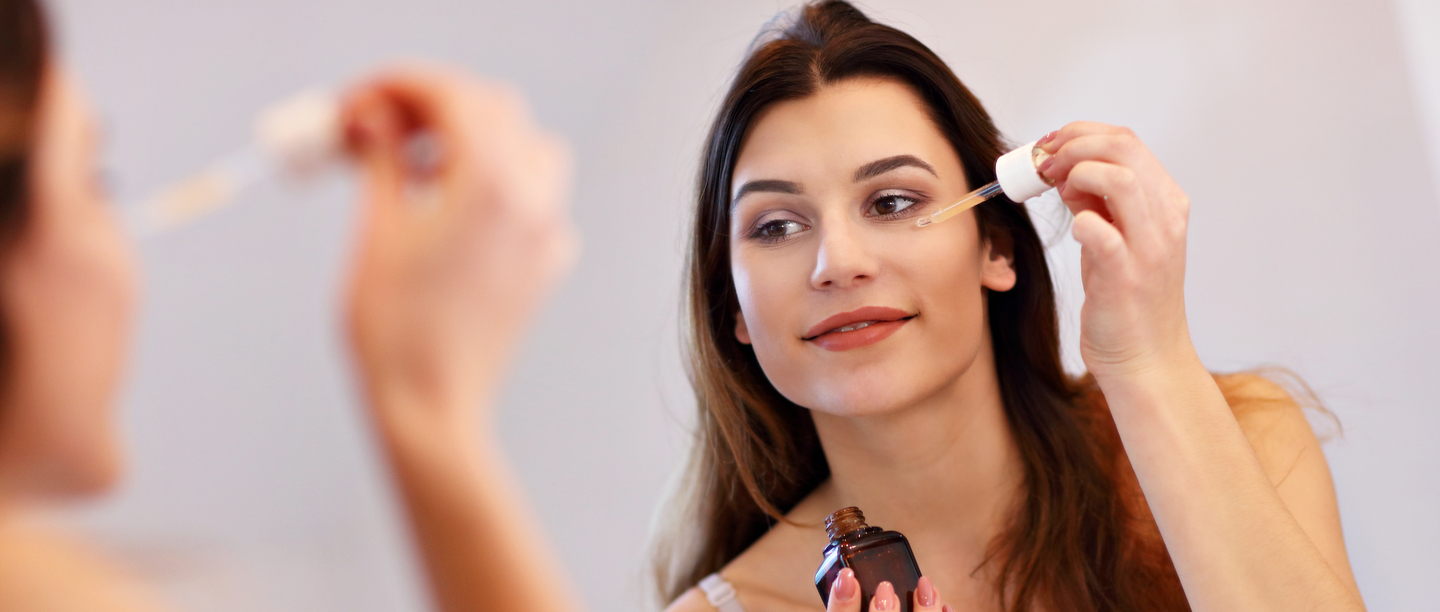
Welcome to the world of face acids. Don’t be frightened by the name. They can do wonders for your skin if you know which one to use. I’m sure you’ve probably seen some of these names in stores and while shopping online – salicylic, lactic, hyaluronic, mandelic, glycolic, ascorbic, oleic, kojic and many more. What are these fascinating skincare ingredients? More so, what’s the correct way to use them? Celebrity Skin Expert & Medical Head of The AgeLess Clinic, Dr Harshna Bijlani, has all the answers!
A No-Nonsense Guide To Face Acids

Shutterstock
The word “acid” may seem like a very strong ingredient to use on the skin, but don’t let that intimidate you.
“The kinds of acids one uses for skincare are ‘organic’ or ‘weak acids’ that have acidic properties that are helpful due to the balance they have to contribute to our skins Ph Levels. So rather than being harmful, they actually help the skin,” explains Dr. Harshana.
How do acids work? Do they actually benefit our skin?
We asked Dr Harshana to break it down for us.
At the most basic level, anything with low pH is an acid, even our own skin pH is acidic in nature. Acids are active ingredients that address a number of different skincare concerns depending on the molecular size of the acid and its strength. The most common skin concerns being addressed by acids are acne, pigmentation, anti-ageing, unclogging pores and skin turnover.
Acids have been used for centuries to renew and rejuvenate the skin. Cleopatra used Lactic acid from milk to exfoliate her skin to European women use stale wine to rinse their faces (tartaric and malic acid, to be specific.) There are various kind of acids that are beneficial for the skin when administered in the right quantity. Some of the popular acids are AHAs, BHAs, PHAs, ascorbic acid and so on.
Shutterstock
Broadly there are 2 acid families you need to familiarize yourself with – AHAs (Alpha Hydroxy Acids), BHAs (Beta Hydroxy Acids).
Popular AHAs are glycolic and lactic acid. These bad boys are known to help with exfoliation, brightening, and anti-ageing.
Popular among the BHAs, and one of Dr Harshana’s favourite is Salicylic acid. She believes it does wonders for acne-prone or oily skin. It helps with discolouration and can be used to reduce rosacea.
Then you have the beauty industry favourite, L-ascorbic acid. It is a derivative of Vitamin C, is an extremely popular acid and has multiple benefits. It helps with radiance and treats UV-photodamage, helps brighten your skin, fade scars wrinkles and hyperpigmentation among others.
Sensitive skin?
You should opt for lactic acid or PHAs (as these are milder).
Pigmentation, dark spots and fine lines?
You should opt for glycolic, mandelic or lactic acid.
Damaged, dull skin?
Ferulic and ascorbic acid are filled with great anti-oxidants which help with pigmentation, anti-ageing, fine lines, hydration and help fight free radical damage.
Dry skin?
Hyaluronic is a great acid to start out with. Mainly because it’s safe for all skin types and helps draw moisture from the environment to your skin. What’s even cooler is that our skin and body produces it. It’s hydrating and has an anti-ageing effect on the skin.
Dry and mature skin?
Dr Harshna recommends oleic acid. According to her, it is essentially classified as a monounsaturated omega-9 fatty acid that’s found in animals and plants like nuts, eggs, olive oil, etc. A good source of antioxidants and has great hydrating and anti-inflammatory properties. Plus, often used to help treat skin and scalp conditions like dry skin, psoriasis, eczema and seborrheic dermatitis.
Special concerns like rosacea and melasma
And finally, if you have special concerns like these, you can count on azelaic acid to nurse your skin back to health. It helps to lighten acne scars and marks among other things.
Tips & Tricks To Keep In Mind While Using Face Acids
Shutterstock
Okay, face acids are awesome! We all agree to that fact, but there are a few things to keep in mind while using them. Dr Harshna fills us in on the deets.
– If you’re combining or layering acids, it’s important to understand which acids can be used together. Eg. Glycolic acid and Vit C work very well together.
– You should not use salicylic acid during pregnancy, however, lactic acid is safe to be used during pregnancy or while breastfeeding.
– Use your acids typically in the night as they tend to make you more photosensitive. And always wear sunscreen the morning after.
– Stop using your acids a couple of days before you get any facial cleaning, threading or waxing done as it tends to make your skin more sensitive.
– When you start using any new acids or acid-based products, do a patch test first.
– Homecare acids are much lower in strength as compared to acids used during in-clinic treatments, like peels. So use your at-home acids to complement your dermatologist treatments, not replace them.
– Acids are a lovely substitute for beaded scrubs (the beads and granules sometimes tend to be too harsh and actually tend to damage your skin). Now there are gommage scrubs which use lovely mild acids to help exfoliate and brighten your skin. One such scrub that Dr Harshna really likes is the Shangpree Fresh Peeling Mask which contains glycolic acid.
Now that you’re all caught up on the A-Z of acids, which one are you tempted to bring home? We’re all ears!
Also Read: Lactic acid for skin
Images: Shutterstock